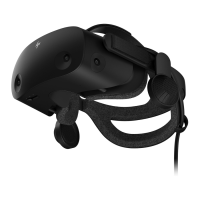
Do you have a question about the HP Reverb G2 and is the answer not in the manual?
| Type | Dedicated head mounted display |
|---|---|
| Product color | Black |
| Recommended age (min) | 13 yr(s) |
| Adjustable interpupillary distance | Yes |
| Display type | LCD |
| Display resolution | 4320 x 2160 pixels |
| Card reader integrated | No |
| Number of battery cells | 1 |
| Depth | 186 mm |
|---|---|
| Width | 75 mm |
| Height | 84 mm |
| Weight | 550 g |
Connect the headset and launch the Mixed Reality Portal for initial setup and driver updates.
Choose VR space setup options like 'all experiences' or 'seated and standing'.
Follow instructions to center the headset, defining the forward direction in VR.
Option to enable speech input in Mixed Reality using the headset's microphones.
Wait for Mixed Reality to download and install necessary components.
Manage Bluetooth connections for controllers and other devices in Windows.
Configure audio output and speech input settings for Mixed Reality.
Customize the VR environment and reset saved space data.
Adjust visual quality and refresh rate for optimal headset performance.
Accessing the Mixed Reality Portal settings menu.
Managing VR space boundaries for safety and defining play areas.
Using the Windows button on controllers to access menus and apps.
Answers to common questions about the HP Reverb G2 and VR platforms.
Explanation of Steam and SteamVR platforms and their roles in VR.
Step-by-step guide to installing Steam and SteamVR on your system.
Instructions for launching SteamVR applications through the Mixed Reality Portal.
Guidance on developing for Windows Mixed Reality without using SteamVR.
Tips for migrating SteamVR content to Windows Mixed Reality.
Information on running SteamVR without an internet connection after installation.
Method for calibrating VR space center and floor height in SteamVR.
Optimizing headset resolution settings for SteamVR and Windows Mixed Reality.
Details on the minimum hardware and software requirements for the headset.
Guidelines for setting up large-scale or free-roam VR experiences.
Instructions for adjusting the headset's interpupillary distance (IPD).
Options for making HP Reverb G2 controllers rechargeable.
Information on the compatibility and testing of cable extensions with the headset.
Specifies the type of video signal cable used by the headset.
Guidance on using DisplayPort adapters with HDMI-only laptops.
Information on the availability of replacement cables and lenses.
Guidance on wearing eyeglasses with the headset and protective options.
Instructions on how to disable the Windows button on VR controllers.
Information on whether the headset supports gesture recognition.
Using third-party software to integrate other controllers with the headset.
Guidance on whether the headset can be used outdoors and associated risks.
Troubleshooting common WMR cable errors and intermittent connection issues.
Recommendation to disable PC sleep mode for optimal VR performance.
Common headset tracking challenges and their resolutions in WMR.
Common hand controller tracking challenges and recommended solutions.
Information on running Windows Mixed Reality offline after initial setup.
Running Oculus applications on the Windows Mixed Reality platform using 'Revive'.
Troubleshooting incorrect VR height settings and how to fix them.
Assessing potential mutual interference issues with multiple WMR devices.
Information on WMR support for developing multi-player applications.
Tips for creating safe shared VR space boundaries for multiple users.
Instructions to disable or enable the Windows button on VR controllers.
Procedure to change the headset's idle timeout setting.
Explanation of the concept of Six Degrees of Freedom (6DOF) in VR.
Trade-offs between developing for SteamVR and natively for Windows Mixed Reality.
Best practices for securing VR content and data.
Definition and use of fiducial markers in VR tracking.
Explanation of inside-out tracking technology used by the headset.
